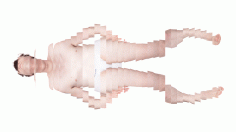Rollin Leonard
source: animalnewyork
ROLLIN LEONARD’S BODY “WAVE” IN 4K ULTRA HD IS HYPNOTIC
That gyrating form above is a low-res gif version of Rollin Leonard’s new video installation. Now imagine looking down at it in 4K Ultra High-definition.
To create the moving image, Leonard built this coffin-style set-up with perfectly even lighting, free of shadow — the only distortion of the body can be depicted as a wave.
From Transfer Gallery’s press release:
Wave is a new work (inspired by the artist’s attempts to teach himself to float in water) depicts the body under the constraints of a strictly limited system… As in much of his work, the artist uses bodies as a way of ascribing agency to less-human objects and ideas.
Seems like Leonard perfected the technique of capturing/illuminating/floating/isolating human forms that he has been obsessed with for so long — a methodical digital manipulation of the human form that, if you stare into long enough and tune in, can make you feel like your atoms are actually tingling pixels and you’re sliding apart and sliding back together in measures pieces and moving planes.
“The shuffling method is a perfect shuffle or a faro shuffle,” Leonard explains. “Cut a deck of cards and interlace each card. With a ‘deck’ of 36 slices it takes only 12 shuffles to return to original arrangement. Here instead of moving parts of the body, I moved the timelines.” Here are a few of his 12 remixes of Wave in gif preview form.
.
.
.
.
.
.
.
source: netartnetnet
Rollin Leonard talks about a process he’s using in creating a new work.
Transcript:
My name is Rollin Leonard, I’m an artist who lives and works in Portland, Maine. A lot of my work uses basic studio photography techniques and simple unseen props that help me manipulate bodies in measured ways. Like this giant protractor here that I’ve made out of my cat’s laser pointer, some paper, and my swiveling chair—this is for a video that I am working on of a bust rotating. The video will be split into nine sections, each rotating at different rates. The video exploits a concept called highly composite numbers.
Highly composite numbers are those which have more divisors than any number smaller than them. It’s kind of the opposite of a prime number in that it can be cut up in a bunch of different ways and keep numbers whole. So it’s not arbitrary that they chose the number 360 to divide up the circle into degrees, because it has 24 divisors and is considered a colossally abundant number. This means I can have bust rotate at nine different rates and reset to a complete body in only 360 frames.
Rollin Leonard is an artist whose work is rooted in crude but systematic studio photography. For the last couple of years the subjects have mostly been bodies and body parts and most of the work has been designed to be experienced online. Rollin was born in 1984 in Boulder Colorado, USA is currently based in Maine. The artist’s work has been shown at such venues as: The Photographer’s Gallery, London; Point Ephémère, Paris; Museum of the Moving Image, New York; Moving Image Art Fair, New York; Essential Existence Gallery, Leipzig; Fach & Asendorf Gallery, online; NADA art fair, New York; and has an upcoming solo show at Transfer Gallery, Brooklyn October 2013.
.
.
.
.
.
.
.
source: rollinleonard
Rollin Leonard is a new media artist whose work is rooted in crude but systematic studio photography. For the last couple of years the subjects have mostly been bodies and body parts and most of the work has been designed to be experienced online. Rollin was born in 1984 in Boulder Colorado, USA is currently based in Maine. The artist’s work has been shown at such venues as: The Photographer’s Gallery, London; Point Ephémère, Paris; Museum of the Moving Image, New York; Moving Image Art Fair, New York; Moving Image Art Fair, London; Essential Existence Gallery, Leipzig; Fach & Asendorf Gallery, online; NADA art fair, New York; and at Transfer Gallery, Brooklyn to name a few. His work is included in international collections including 53 Museum Guangzhou, China.


